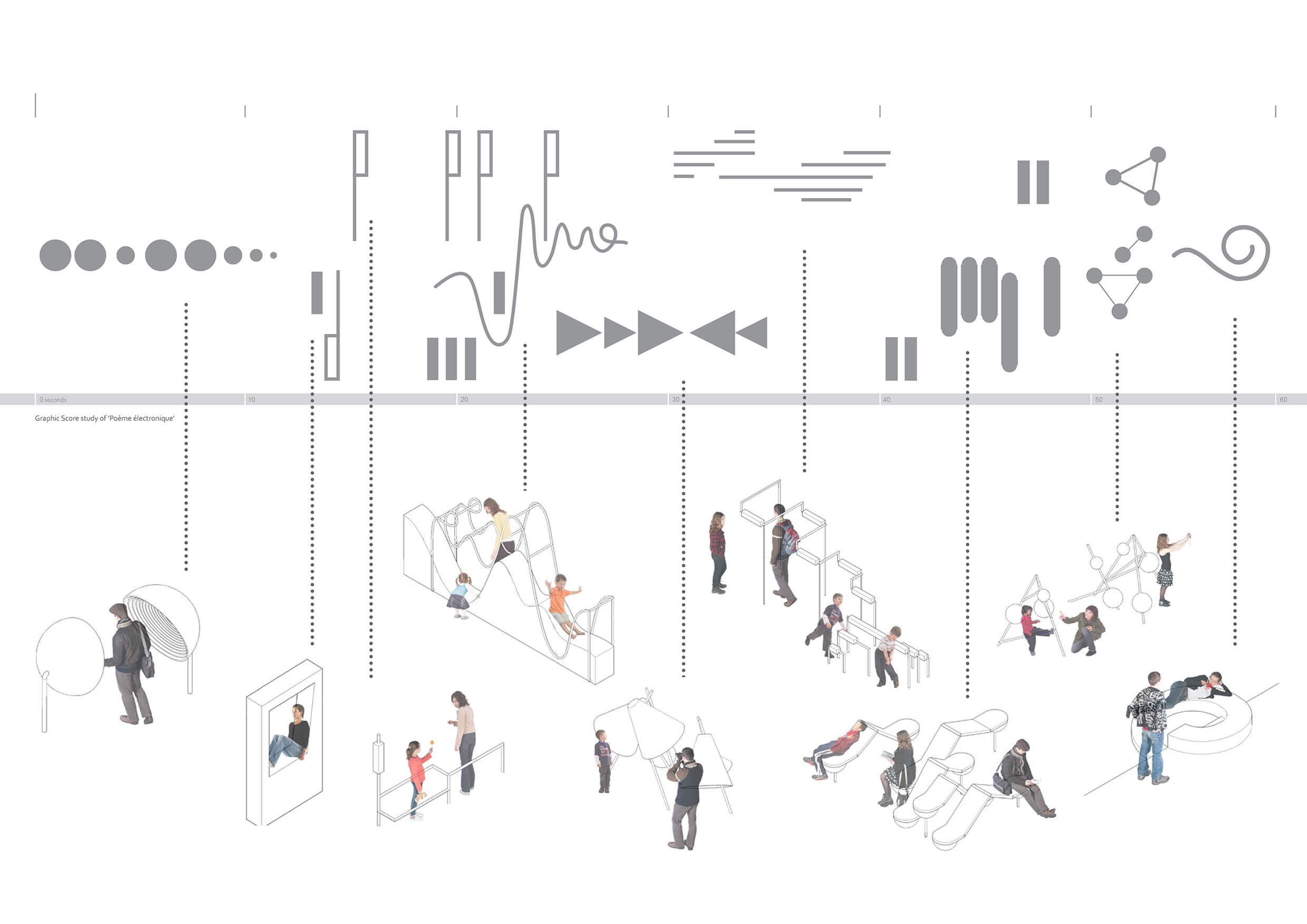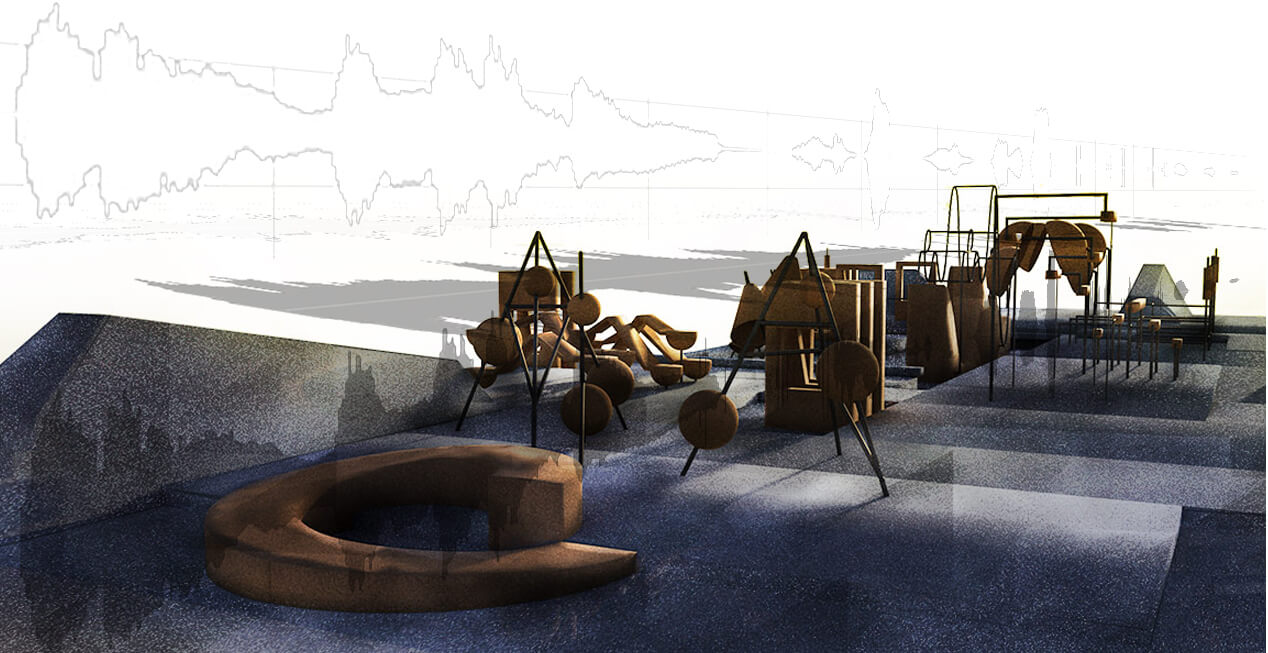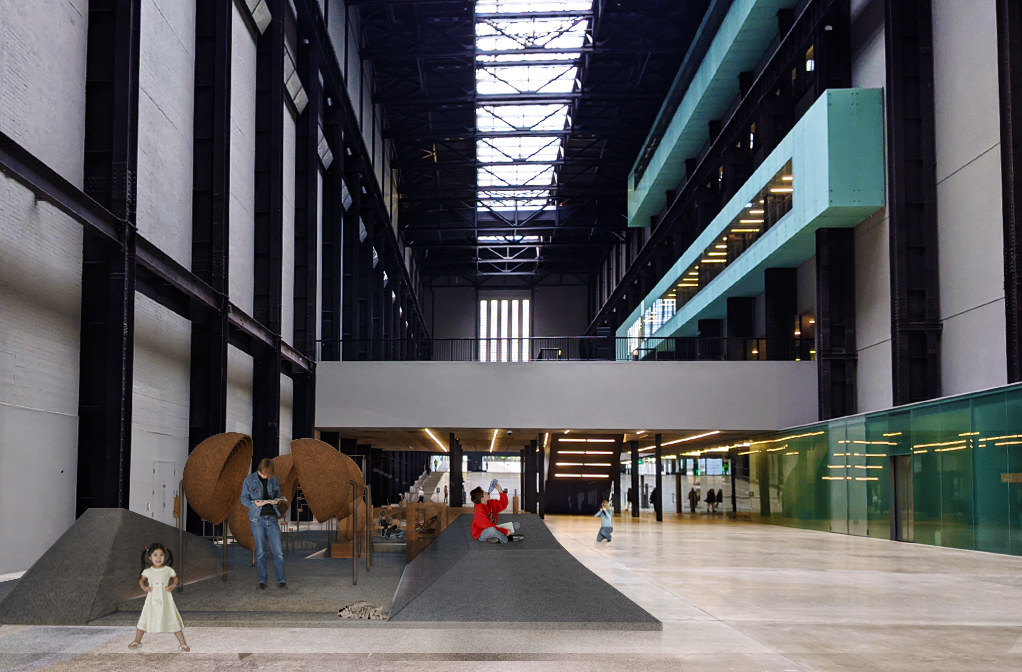sonuscape
ARCHITECTURE AS A SONIC MEDIUM
For several hundred years Western music has been based on composition and performance. Most attention has been focused on the conception and generation of sound, very little on its propagation. (...) No matter how complex a system of notation or how real the illusion of depth, written music is trapped on a flat plane.
Alvin Lucier in Careful Listening is More Important than Making Sounds Happen - The Propagation of Sound in Space, c.1979
How can soundscapes become real play/landscapes?
Sonuscape is a preliminary architectural design process that studies of an hypothetical 3D Graphic Scores.
CONTEXT
John Cage published Notations with A.Knowles in 1969. By inviting interdisciplinarity between various artistic expressions and techniques in the sonic realm various methods of communicating Sound were introduced, such as Graphic Scores. The presentation as well as interpretation of music gain a new perspective by opening music to this artistic spectrum. Various composers such as Elliot Carter, Steve Reich, Terry Riley and Cornelius Cardew gave major contributions to this paradigm and its artistic development and extensions.
The future therefore belongs to the philophonics.
Erik Satie in Memories of an Amnesic (Fragments 1912-13), Paris, 15 April 1912
Interdisciplinarity is analysed on a more recent edition of Graphic Score works. In 2009 Theresa Sauer explores on her book Notations 21 a contemporary view of these compositional sketches on a globalized society. She displays an integrative approach framed by our media and globalized society that introduce us what might be a potential reflection of a new vocabulary in the Sonography scene [cfr. R. M. Schafer in The Soundscape, 1977].
Sound Art took quite a leap when combined with visual arts; also architecture has been inherently presented as a visual art form. The developed hegemony of vision in Western culture has been one of Juhani Pallasmaa’s reflection and analysis on his book The Eyes of the Skin.
Sharing the same view and concern as Pallasmaa on ‘the consequent disappearance of sensory and sensual qualities from the arts and architecture’, as well as his thoughts on architecture working as a mediaton tool for a phenomenological experience, SonuScape arose. This is a project study that explores the combination of sensorial awareness, where abstract sonic systems are transferred into an architectural realm, driven by the cross-pollinating and integrative attitude drawn by Cage.
CASE STUDY
Hypothetical Graphic Score digital design for Edgar Varèse’s piece Poème électronique [first 60 sec.]
Music is not a language. Every musical piece is like a complex rock, formed by ridges and designs engraved within and without, that can be interpreted in a thousand different ways (...) By virtue of this multiple exegesis, music inspires all sorts of fantastic imaginings, like a Crystal catalyst.
Iannis Xenakis in Ditatope, pag.216, 2006
How to develop an architectural design and sonic analysis process? From 2D to 3D.
In this case study I chosed an excerpt [first 60 seconds] of Edgar Varèse sound work Poème Électronique premiered in 1958 at the Brussels World Fair.
The design method for the process thinking/making of this study was drawn by a scrutinized investigation os design precedents: of various playgrounds (specifically post-World War II) as well as sculpture, urban furniture and landscape architectural works developed by artists that reflected the Zeitgeist of Poème Électronique specific time (such as Lina Bo Bardi, Egon Möller, Isamu Noguchi, Aldo Van Eyck,...). Alongside this research, I was also supported by DAW software which enable me to forensically analyse the spectrogram and sonograph of the sonic work, as well as its panning. All these examples and their interpretation and cross-pollinations were crucial for me to scale, structure, distribute and map out objects in an hypothetical landscape.

SonuScape works as a synthesized playful and learning system, where one will be able to interact with each piece and trigger it.
SonuScape suggestion of project display at Tate Modern's Turbine Hall. First case study: system interpretation of Varèse sound work Poème Électronique
All in all, the creative act is not performed by the artist alone; the spectator brings the work in contact with the external world by deciphering and interpreting its inner qualifications and thus adds his contribution to the creative act.
Marcel Duchamp in ‘The Creative Act’- Lecture at the Museum of Modern Art, New York, October 19th, 1961
Technical details
Materials sculptural pieces designed mostly in cork and metal tubing; speakers and sensors to be revised according to design
Dimension variable
Duration variable [according to sound piece choosed]
Software DAW software for audio analysis, 3D architectural software [ Rhino6, CAD, ...], MaxMSP and Arduino for interactivity feature
project history
2021.10.01 Conference paper SonuScape: architecture as a medium for sound published in EAEA15 edition.
2021.09.03 Project presented at EAEA15 Conference
2020.01.08 Project featured in Future Architecture Platform
2019.04.06 Guest Lecturer at Sonic Arts Forum Huddersfield University [UK]
2018.06.03 - 06.14 Shortlisted and Premiered - Sound Art Exhibition Morley Gallery, London [UK]



